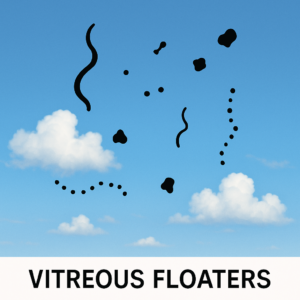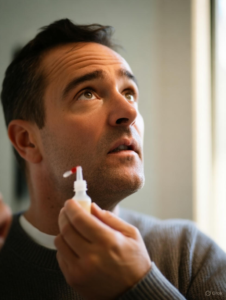What Is Pinguecula? Symptoms, Treatment, and Surgical Options
Yellow Spot and Bump on the Eye: What You Should Know About Pinguecula
Pinguecula Surgery — Is It Necessary? When and How Is It Done?
Pinguecula vs Pterygium: Differences, Treatment, and Risks
Patients often describe it like this:
-
“There’s a yellowish spot on the white part of my eye.”
-
“I feel a small bump in my eye — sometimes it itches and feels irritated.”
-
“It looks like a fat stain on the white part, but I thought it might be pterygium like my friend’s.”
-
“It doesn’t reach the cornea, but it keeps getting red and stings sometimes.”
If you have noticed a similar yellowish spot or bump on your eye, the following information about pinguecula will be useful to you.
What Is Pinguecula?
Definition:
Pinguecula is a benign (noncancerous) change in the conjunctiva, the thin membrane covering the white part of the eye.
The term comes from the Latin word “pinguis” meaning “fat,” because the lesion may contain deposits of fat, protein, or calcium.
It usually does not grow onto the cornea (the clear front surface of the eye), so it rarely affects vision directly.
Pingueculae most often appear on the nasal side of the eye (near the nose).
Who Is at Risk?
-
More common with age
-
Caused by sunlight (UV exposure), wind, dust, and dry climates
-
People with dry eye or who wear contact lenses are at higher risk
Difference Between Pinguecula and Pterygium (“Eye Growth”)
| Feature | Pinguecula | Pterygium |
|---|---|---|
| Growth direction | Usually does not extend onto the cornea | Often grows onto the cornea |
| Appearance | Yellowish bump, less vascular | Thicker, with visible blood vessels |
| Effect on vision | Rarely affects vision | May distort cornea and affect sight |
| Primary concern | Cosmetic, irritation | Cosmetic + visual |
Symptoms — What Patients Feel
Pinguecula often causes no symptoms, but may sometimes lead to:
-
Burning, stinging, or gritty sensation
-
Eye dryness or watering
-
Redness, especially with irritation
-
Foreign body sensation (as if sand or dust is in the eye)
-
Sensitivity to light
-
Cosmetic discomfort (visible bump)
In most cases, it does not cause blurred vision.
Treatment Options — When and How?
Conservative / Medical Treatment
Most cases don’t require surgery.
If symptoms occur:
-
Artificial tears or gel drops to keep the surface moist
-
Short-term steroid or anti-inflammatory drops if redness or inflammation develops
Surgical Treatment (Pinguecula Removal)
When is surgery considered?
-
Persistent irritation, burning, or discomfort
-
Cosmetic reasons
-
Interference with contact lens use
How is it done?
-
Performed under local anesthetic eye drops, pain-free
-
The lesion is carefully removed
-
A conjunctival graft (from the patient’s own tissue) or sliding tissue flap may be applied
-
No stitches — a tissue adhesive is used
-
The procedure takes 10–15 minutes
-
The eye may be bandaged briefly; antibiotic and steroid drops are prescribed
Postoperative recovery:
-
Outpatient procedure (no hospital stay)
-
Mild discomfort for a few days
-
Follow-up with drops for healing
-
Full recovery within a few weeks
Why Some Doctors Don’t Recommend Surgery
Because most pingueculae are harmless and stable, the risk-benefit ratio of surgery may not justify intervention.
Mild cases respond well to artificial tears and observation.
Also, not all ophthalmologists perform this specialized surgery, as it’s rarely necessary.
🔹 Frequently Asked Questions (FAQ)
What is Pinguecula?
A yellowish, raised area on the white of the eye caused by sun, dust, or dryness. It’s benign and doesn’t affect vision.
What causes Pinguecula?
Chronic exposure to UV light, wind, dust, or dry environments, as well as aging and dry eyes.
Is Pinguecula the same as Pterygium?
No. Pterygium extends over the cornea; pinguecula usually does not.
Does Pinguecula go away by itself?
It rarely disappears but may remain stable for years.
When is surgery needed?
When it causes constant irritation, cosmetic concern, or difficulty wearing lenses.
How is Pinguecula surgery performed?
Under local anesthesia, the lesion is removed and replaced with a small tissue graft using glue, not stitches.
Is it painful?
No — only mild discomfort afterward.
Can it come back?
Recurrence is extremely rare with modern surgical techniques.
Does it affect vision?
No, unless severe dryness or irritation occurs.
Where can I have it treated?
At Kaşkaloğlu Eye Hospital, experienced surgeons perform pinguecula surgery using modern, minimally invasive, and tissue-preserving techniques with excellent cosmetic results.
SEO keywords:
pinguecula, pinguecula surgery, yellow spot on the eye, pinguecula symptoms, pinguecula treatment, pterygium difference, eye bump














